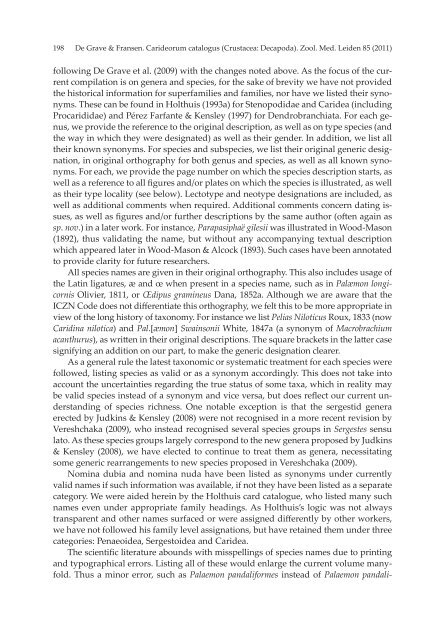Download PDF as one large file - AToL Decapoda
Download PDF as one large file - AToL Decapoda
Download PDF as one large file - AToL Decapoda
You also want an ePaper? Increase the reach of your titles
YUMPU automatically turns print PDFs into web optimized ePapers that Google loves.
198 De Grave & Fransen. Carideorum catalogus (Crustacea: <strong>Decapoda</strong>). Zool. Med. Leiden 85 (2011)<br />
following De Grave et al. (2009) with the changes noted above. As the focus of the current<br />
compilation is on genera and species, for the sake of brevity we have not provided<br />
the historical information for superfamilies and families, nor have we listed their synonyms.<br />
These can be found in Holthuis (1993a) for Stenopodidae and Caridea (including<br />
Procarididae) and Pérez Farfante & Kensley (1997) for Dendrobranchiata. For each genus,<br />
we provide the reference to the original description, <strong>as</strong> well <strong>as</strong> on type species (and<br />
the way in which they were designated) <strong>as</strong> well <strong>as</strong> their gender. In addition, we list all<br />
their known synonyms. For species and subspecies, we list their original generic designation,<br />
in original orthography for both genus and species, <strong>as</strong> well <strong>as</strong> all known synonyms.<br />
For each, we provide the page number on which the species description starts, <strong>as</strong><br />
well <strong>as</strong> a reference to all figures and/or plates on which the species is illustrated, <strong>as</strong> well<br />
<strong>as</strong> their type locality (see below). Lectotype and neotype designations are included, <strong>as</strong><br />
well <strong>as</strong> additional comments when required. Additional comments concern dating issues,<br />
<strong>as</strong> well <strong>as</strong> figures and/or further descriptions by the same author (often again <strong>as</strong><br />
sp. nov.) in a later work. For instance, Parap<strong>as</strong>iphaë gilesii w<strong>as</strong> illustrated in Wood-M<strong>as</strong>on<br />
(1892), thus validating the name, but without any accompanying textual description<br />
which appeared later in Wood-M<strong>as</strong>on & Alcock (1893). Such c<strong>as</strong>es have been annotated<br />
to provide clarity for future researchers.<br />
All species names are given in their original orthography. This also includes usage of<br />
the Latin ligatures, æ and œ when present in a species name, such <strong>as</strong> in Palæmon longicornis<br />
Olivier, 1811, or Œdipus gramineus Dana, 1852a. Although we are aware that the<br />
ICZN Code does not differentiate this orthography, we felt this to be more appropriate in<br />
view of the long history of taxonomy. For instance we list Peli<strong>as</strong> Niloticus Roux, 1833 (now<br />
Caridina nilotica) and Pal.[æmon] Swainsonii White, 1847a (a synonym of Macrobrachium<br />
acanthurus), <strong>as</strong> written in their original descriptions. The square brackets in the latter c<strong>as</strong>e<br />
signifying an addition on our part, to make the generic designation clearer.<br />
As a general rule the latest taxonomic or systematic treatment for each species were<br />
followed, listing species <strong>as</strong> valid or <strong>as</strong> a synonym accordingly. This does not take into<br />
account the uncertainties regarding the true status of some taxa, which in reality may<br />
be valid species instead of a synonym and vice versa, but does reflect our current understanding<br />
of species richness. One notable exception is that the sergestid genera<br />
erected by Judkins & Kensley (2008) were not recognised in a more recent revision by<br />
Vereshchaka (2009), who instead recognised several species groups in Sergestes sensu<br />
lato. As these species groups <strong>large</strong>ly correspond to the new genera proposed by Judkins<br />
& Kensley (2008), we have elected to continue to treat them <strong>as</strong> genera, necessitating<br />
some generic rearrangements to new species proposed in Vereshchaka (2009).<br />
Nomina dubia and nomina nuda have been listed <strong>as</strong> synonyms under currently<br />
valid names if such information w<strong>as</strong> available, if not they have been listed <strong>as</strong> a separate<br />
category. We were aided herein by the Holthuis card catalogue, who listed many such<br />
names even under appropriate family headings. As Holthuis’s logic w<strong>as</strong> not always<br />
transparent and other names surfaced or were <strong>as</strong>signed differently by other workers,<br />
we have not followed his family level <strong>as</strong>signations, but have retained them under three<br />
categories: Penaeoidea, Sergestoidea and Caridea.<br />
The scientific literature abounds with misspellings of species names due to printing<br />
and typographical errors. Listing all of these would en<strong>large</strong> the current volume manyfold.<br />
Thus a minor error, such <strong>as</strong> Palaemon pandaliformes instead of Palaemon pandali-

















